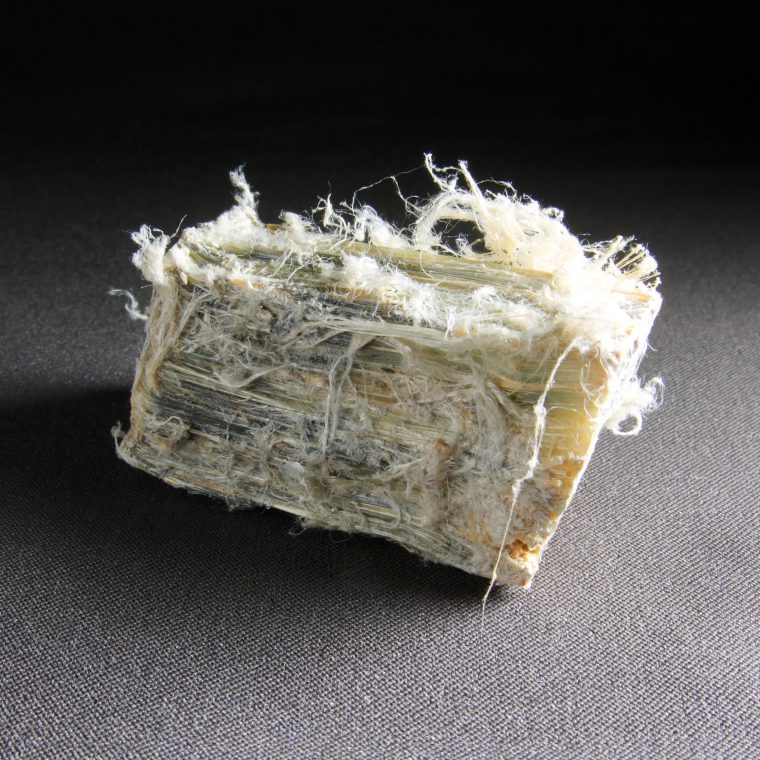PART I – GENERAL INFORMATION ABOUT ASBESTOS
1.1 WHAT IS ASBESTOS?
Asbestos is the name given to a group of naturally occurring fibrous silicate minerals found in rock formations. There are six minerals—chrysotile, amosite, crocidolite, anthophyllite, tremolite and actinolite. Most asbestos forms are amphibole except chrysotile which is serpentine. Chrysotile makes up about 90% or more of asbestos used in Colombia.
All asbestos minerals have been used in many products in Colombia for more than seventy-five years. Most of the asbestos containing materials have been consumed in the construction and motor sectors. Some products have been manufactured in Colombia and some imported.
Asbestos-containing materials can be dangerous to health if they are not properly maintained or removed carefully, because they will release inhalable fibres.
What is the difference between friable and non-friable asbestos?
There are two types of asbestos-containing materials: friable and non-friable. Non-friable asbestos is also known as bonded asbestos.
Friable asbestos refers to asbestos containing materials (ACM) that can easily be reduced to powder or crumble when crushed by hand. These materials can contain high percentages of asbestos fibres which are more likely to release into the air if the material is disturbed. As such, they pose a greater risk to health.
Examples of friable asbestos-containing materials include:
- sprayed on fire retardants and insulation
- sound proofing and insulation
- the backing of sheet vinyl and linoleum floor coverings
- thermal lagging, such as pipe insulation.
Non-friable asbestos products are made using a bonding compound, such as cement, mixed with a proportion of asbestos. The proportion of asbestos can vary, for example in the case of gaskets and brake pads, the asbestos content can be up to 50%. The asbestos fibres are bound in the product (hence the term bonded asbestos). Non-friable asbestos products are solid, rigid and cannot be crumbled or reduced to powder by hand pressure.
When they’re in good condition, non-friable asbestos products do not normally release any asbestos fibres into the air. They are considered a low risk for people who are near them. However, when non-friable asbestos products are damaged, disturbed or badly weathered (including hail or earthquake damage), they may release fibres or become friable.
Examples of non-friable asbestos-containing materials include:
- asbestos cement products (flat, profiled and corrugated sheeting used in walls, ceilings and roofs, molded items such as downpipes and water tanks)
- reinforced plastics
- gaskets
- adhesives, paints and coatings
- floor tiles
- firefighting clothing and blankets
1.2 HEALTH RISKS OF ASBESTOS
Asbestos fibres are so small that they are not visible to the naked eye, they have no taste and no smell. It is impossible to identify the presence of asbestos by visual inspection. The only way to be certain is to have a sample of the material analysed by a laboratory.
Asbestos fibres can become airborne from handling or breakdown of manufactured asbestos products. The fibres are so small and light that once released from the material, they can remain in the air for a long period (about 72 hours), making them easy to breathe into the lungs. When airborne fibres are breathed into the lungs, they can cause life-threatening illnesses.
Asbestos-related diseases
Asbestos fibres can remain deep in the lung after inhalation and may cause several diseases, including mesothelioma, lung cancer and asbestosis, which usually take many years, sometimes decades, to develop.
Scientific studies reviewed by the International Agency for Research on Cancer (IARC, 2012) show that inhaled asbestos fibres can also cause cancer of the larynx and ovaries and is associated with pharynx, stomach and colorectal cancer.
The four major asbestos-related diseases are listed below. A person may develop more than one of these diseases.
Pleural plaques
- areas of white, smooth, raised scar tissue on the outer lining of the lung, internal chest wall and diaphragm
- often the earliest sign of exposure to asbestos
- not everyone who has been exposed to asbestos develops plaques, possibly because of differences in their immune response to asbestos fibres
- people with pleural plaques as their only asbestos related symptom usually have very little impairment of lung function.
Asbestosis
- a chronic condition caused by inflammation or scarring in the lungs
- causes shortness of breath, coughing and permanent lung damage
- Lung cancer
- cancerous tumors that mainly occur in the lining of the tubes leading into the lungs, the smaller airways or the middle of the lungs
- risk of developing lung cancer is greatly increased in people who also smoke.
Mesothelioma
- a rare form of cancer of the tissue that lines the body cavities, particularly the chest and abdominal cavities.
Risk factors for developing asbestos-related diseases
The likelihood of any person developing an asbestos-related illness may depend on several factors, including:
- length of time a person is exposed to airborne asbestos fibres
- concentration or levels of asbestos in the air
- individual susceptibility
- size and type of asbestos fibres
- cigarette smoke – research has shown that smoking significantly increases the risk of lung cancer in people who have been exposed to asbestos.
However, some people who develop an asbestos-related disease have only been exposed once, whereas others who were regularly exposed to airborne asbestos fibres do not become ill.
According to the World Health Organization there is no safe level of exposure to inhaled asbestos fibres and all forms of asbestos (including chrysotile) are carcinogenic to humans.
When are people likely to be exposed to asbestos?
Everyone is exposed to low levels of asbestos in the air we breathe every day. Ambient or background air usually contains between 10 and 200 asbestos fibres in every 1000 litres (or cubic metre) of air (equivalent to 0.01 to 0.20 fibres per litre of air). However, people rarely, if ever, become ill from this exposure.
Asbestos exposure is a concern for the following occupations and processes:
- Mining of asbestos occurring from natural mineral deposits
- Processing of asbestos minerals (millers)
- Manufacture of asbestos-containing products eg Asbestos Cement tiles or friction products
- Construction industry – disturbing asbestos-containing materials during building renovations or demolitions and asbestos abatement
- Mechanics – vehicle brake and clutch repairs
- Marinas – renovating or demolishing ships constructed with asbestos-containing materials
- Insulation workers and heating trades
- Sheet metal workers, plumbers and pipe fitters
- Workers responsible for disposing of asbestos waste, and waste workers
- Aqueduct maintenance workers
There are also exposure risks for family members if workers do not fully decontaminate before coming home.
A further exposure risk is to residents and workers in buildings that contain asbestos materials, and these risks will remain until the asbestos is removed from the built environment.
Drinking water
Drinking water has often been transported, collected and stored in asbestos-cement pipes and household tanks from asbestos cement roofing material. The World Health Organisation has concluded that the health risk posed by ingestion of asbestos fibres in drinking water is so low it is unable to be studied.
However, asbestos fibres that have been dislodged by water can be a concern when the water dries out as they can be inhaled. Examples include run off from asbestos roofs collecting in guttering or dried asbestos debris after a flood.
1.3 HISTORY OF ASBESTOS USE IN COLUMBIA
- 1942 – Eternit commenced industrial use and production of asbestos. The first transformer plant for this mineral was built in 1942, in Sibaté, near Bogotá, under the name of Eternit Colombiana.
- 1945 – subsidiaries of Eternit appeared in Barranquilla (Eternit Atlántico) and Yumbo (Eternit Pacífico).
- 1957 – Chaid Neme Hermanos opened Indubestos in Bogotá to produce auto parts such as brakes and packaging.
- 1967 – Asbestos cement company Colombit appeared in Manizales
- 1974 – A chrysotile asbestos mine opened operations in the department of Antioquia
- 1983 – Asbestos cement company Manilit appeared in Manizales
- 1986 – the use of amphibole asbestos was prohibited
- 2011 – low density and friable chrysotile asbestos products were banned such as spray or sprayform.
Over 3,600 asbestos products have been used in Colombia which can be found in homes, vehicles, plant and buildings including factories, offices, schools and hospitals.
Product examples
Asbestos may be found in the following products in residential and commercial premises:
roofing and gutters
- water tanks
- gables and eaves
- internal and external wall cladding
- ceilings
- vinyl, carpet and tile underlay
- lining behind wall tiles
- fencing
- fire door (with an asbestos core)
- chimney and stove flues
- gaskets, brake pads in vehicles
- lagging around pipes
- plant and other machinery containing asbestos gaskets and/or seals
- switchboards
- boilers and heat protection boards behind or underneath boilers.










